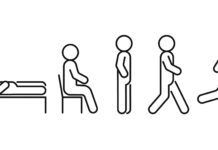Page 17
Strength training, also known as resistance training, is a form of physical activity that exercises a muscle or muscle group against external resistance. It can be performed using free weights, weight machines, resistance bands, or stability balls, or using your own body weight to supply the resistance.
Resistance exercise comes with its own terminology. A repetition, or “rep,” is the number of times you perform a complete movement of a given exercise, such as a bicep curl. A set is a group of reps. If you do two sets of 10 bicep curls (10 reps) in an exercise session, it would total 20 bicep curls.
To meet your goal of increasing muscle strength, resistance training should be progressive. You should gradually increase the resistance or level of difficulty and number of sets up to a maximum of three sets per exercise. For example, you mightstart with two sets of bicep curls with 12 reps using five-pound weights, then progress to three sets of eight to 10 reps using five pound weights, gradually working up to 15 reps per set. Once you’re able to do 15 reps per set of bicep curls with five-pound weights, you can increase the weights to eight pounds and gradually increase the number of reps and sets in the same fashion as you did with the five-pound weights. When you progressively overload muscles in this way, you’ll get increases in strength and perhaps mass.
•• There is no set length for strength-training exercise sessions, but the goal is to do eight to 12 repetitions of each exercise and, if you’re able, you can do two or three sets (of eight to 12 repetitions) of each exercise.
•• You can do eight to 10 different resistance exercises in a session, two to three days per week.
•• You rest two to three minutes between sets and between different exercises to keep your muscles from becoming overly tired.
•• Avoid lengthy sessions (longer than 45 minutes) because you’ll become more fatigued and increase your risk of injury. Generally, 20- to 45-minute resistance training sessions are recommended for older adults.
•• Do not exercise the same muscle groups on two consecutive days. After resistance exercise, muscles need recovery time, as your body starts to repair and replace damaged muscle fibers, forming new strands of muscle protein that result in stronger muscle tissue and, in some cases (particularly in younger individuals and men), bigger muscles.
•• As you become more advanced, you may prefer to split up your muscle-training routine, which means you might exercise specific muscle groups one or two days a week and the remaining muscle groups on a separate one or two days. This is fine, as long you allow at least 48 hours of recovery time for each muscle group.
To learn more about how regular exercise can help your overall fitness and well-being, purchase a copy of Eat Well and Exercise from Tufts Health and Nutrition Letter.

























